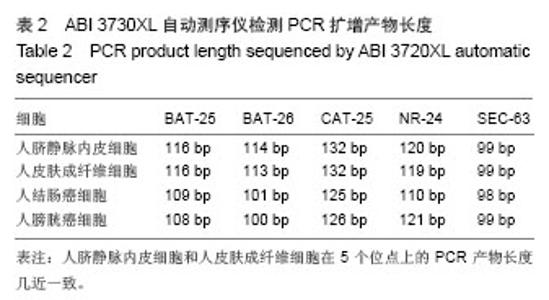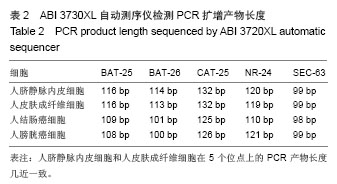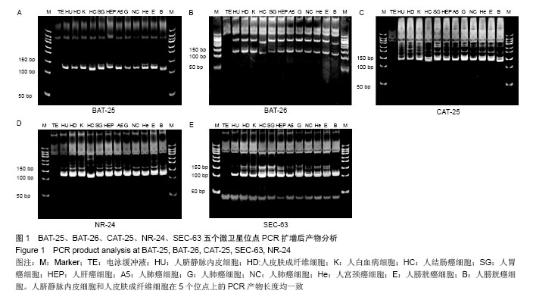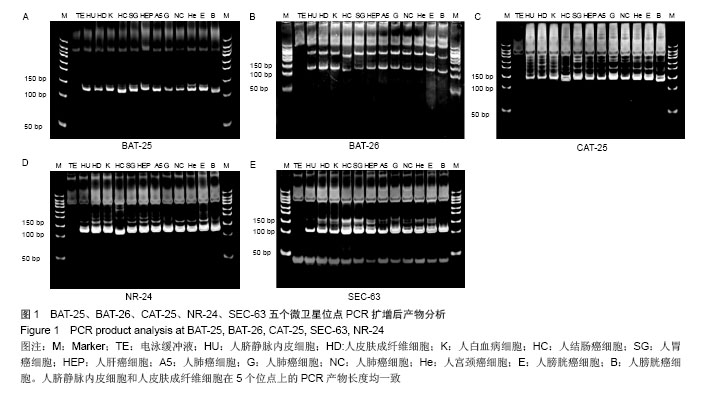| [1]Schmutte C, Fishel R.Genomic instability:First step to carcinogenesis. Anticancer Res.1999:19:4665-4696.
[2]Charames GS, Bapat B.Genomic instability and cancer. Curr Mol Med.2003; 3:589-596.
[3]周尊强,赵金鹏.微卫星不稳定性与恶性肿瘤[J].国际遗传性杂志, 2006,29(1):74-76.
[4]卿海燕,刘冰.肿瘤微卫星异常改变的研究进展[J].中国肿瘤, 2007, 16(6):422-425.
[5]Tautz D. Hypervariability of simple sequences as a general source for polymorphic DNA markers. Nuleic Acids Research. 1989;17(16):6463-6467.
[6]Padar Z, Egyed B, Kontadakis K, et al. Canine STR analyses in forensic practice.Observation of a posseble mutation in a dog hair. J Legal Med. 2002;116(5):286-288.
[7]Gadducci A, Cosio S, Gneazzani AR, et al. Tissue and serum biomarkers as prognostic variables in endometrioid-type endometrial cancer. Oncol Hematol. 2011;80(2):181-192.
[8]Irion DN, Schaffer AL, Famula TR, et al. Analysis of Genetic Variation in 28 Dog Breed Populations With 100 Microsatellite Markers. J Hered. 2003;94(1):81-87.
[9]Parker HG, Kim LV, Sutter NB, et al. Genetic Structure of the Purebred Domestic Dog. Science. 2004;304(4):1161-1164.
[10]Vilar E, Gruber SB. Microsatellite instability in colorectal cancer-the stable evidence. Nat Rev Clin Oncol. 2010; 7(3): 153-162.
[11]姚旭,孟令勤,刘源,等.胆管癌中微卫星不稳定的变化[J].现代肿瘤医学,2012,20(8):1646-1647.
[12]Cervantes A,Rodríguez Braun E,Pérez Fidalgo A,et al. Molecular biology of gastric cancer. Clin Transl Oncol. 2007; 9(2):208-215.
[13]Lengauer C, Kinzler KW, Vogelstein B. Genetic instability in human cancers. Nature.1998:396(2):643-649.
[14]Vaish M, Mittal B. DNA mismatch repair, microsatellite instability and cancer. Indian J Exp Biol. 2002;40(5):989-994.
[15]Boland CR, Goel A. Microsatellite instability in colorectal cancer. Gastroenterology. 2010;138(6):3073-2087.
[16]Negrini S, Gorgoulis VG, Halazonetis TD.Genomic instability- an evolving hallmark of cancer. Nat Rev Mol Cell Biol. 2010; 11(3):220-228.
[17]Kaur G, Masoud A, Raihan N, et al. Mismatch repair genes expression defects & association with clinicopathological characteristics in colorectal carcinoma. Indian J Med Res. 2011;134(2):186-192.
[18]Woerner SM,Kloor M, von Knebel Doeberitz M, et al. Microsatellite instability in the development of DNA mismatch repair deficient tumors. Cancer Biomark. 2006; 2(1):69-86.
[19]Yuji Takahashil, Kazuya Kondol, Toshiyuki Hirosel, et al. Microsatellite instability and protein expression of the DNA mismatch repair gene, hMLH1, of lung cancer in chromate- exposed workers. Mol Carcinogenesis. 2005;42(3):150-158.
[20]秦丹卿,孟祥宁,白静,等.DNA错配修复与肿瘤的发生及治疗[J]. 国际遗传学杂志,2011,34(6):294-299.
[21]Gay LJ, Arends MJ, Mitrou PN, et al. MLH1 promoter methylation, diet, and lifestyle factors in mismatch repair deficient colorectal cancer patients from EPIC-Norfolk. Nutr Cancer. 2011;63(7): 1000-1010.
[22]闻旭阳,戴广海.hMLH1基因启动子CpG岛甲基化,微卫星不稳定与胃癌[J].中国医药导报,2011,8(7):9-10.
[23]LING Zhi-qiang,LI Pei,GE Ming-hua, et al. Aberrant methylation of different DNA repair genes demonstrates distinct prognostic value for esophageal cancer. Digest Dis& Sci. 2011;56(10):2992-3004.
[24]Dietmaier W. Microsatellite instability. A new predictive marker. Pathologe. 2010;31(2):268-273.
[25]Sargent DJ, Marsoni S, Monges G, et al. Defective mismatch repair as apredictive marker for lack of efficacy of fluorouracil- based adjuvant therapy in colon cancer. J Clin Oncol. 2010; 28(20):3219-3226.
[26]Cristina Bilbao, Pedro Carlos Lara, et al. Microsatellite instability predicts clinical outcome in radiationtreated endometrioid endometrial cancer. Int J Radiat Oncol Biol Phyicss. 2010;76(1):9-13.
[27]Woerner SM, Gebert J, Yuan YP, et al. Systematic identification of genes with coding microsatellites mutated in DNA mismatch repair-deficient cancer cells. Int J Cancer. 2001;93(1):12-19.
[28]Buhard O, Suraweera N, Lectard A, et al. Quasimonomorphic mononucleotide repeats for high-level microsatellite instability analysis. Dis Markers. 2004; 200(4-5):251-257.
[29]Bianchi F, Galizia E, Catalani R, et al. CAT25 is a mononucleotide marker to identify HNPCC patients. J Mol Diagn. 2009;11(3):248-252.
[30]Boland CR, Thibodeau SN, Hamilton SR, et al. A national cancer institute workshop on microsatellite instability for cancer detection and familial predisposition: Development of international criteria for the determination of microsatellite instability in colorectal cancer. Cancer Res.1998;58(4): 5248-5257.
[31]Zhou XP, Hoang JM, Cottu P, et al. Allelic profiles of mononucleotide repeat microsatellites in control individuals and in colorectal tumaors with and without replication errors. Oncogene. 1997;15 (3): 713-1718.
[32]Suraweera N, Iacopetta B, Duval A, et al. Conservation of mononucleotide repeats within 3' and 5' untranslated regions and their instability in MSI-H colorectal cancer. Oncogene. 2001;20(7):7472-7477.
[33]Deschoolmeester V, Baay M, Wuyts W, et al. Detection of microsatellite instability in colorectal cancer using an alternative multiplex assay of quasi-monomorphic mononucleotide markers. J Mol Diagn. 2008;10(2):154-159.
[34]Hoang JM, Cottu PH, Thuille B, et al. BAT-26, an indicator of the replication error phenotype in colorectal cancers and cell lines. Cancer Res. 1997;57(2):300-303.
[35]Gayet J,Zhou XP,Duval A,et al.Extensive characterization of genetic alterations in a series of human colorectal cancer cell lines. Oncogene. 2001;20(5):5025-5032.
[36]Ionov Y, Matsui SI, Cowell JK. A role for p300/CREB binding protein genes in promoting cancer progression in colon cancer cell lines with microsatellite instability. PNAS.2004; 101(5):1273-1278. |



